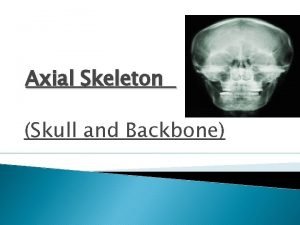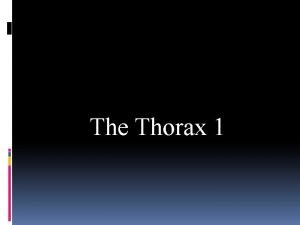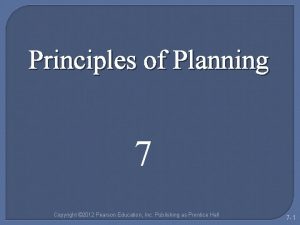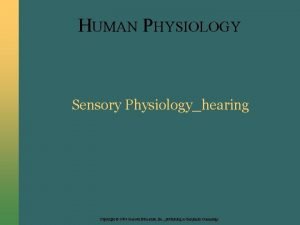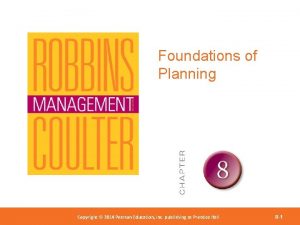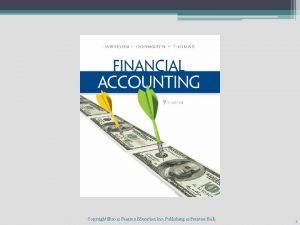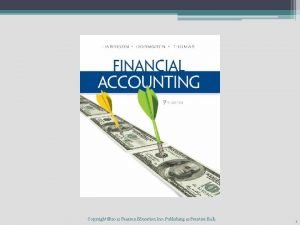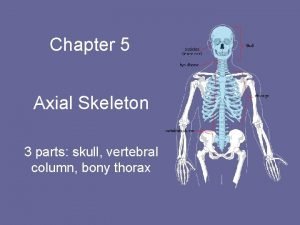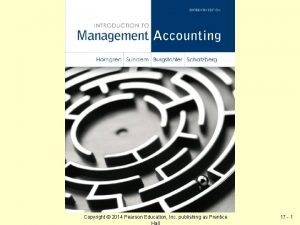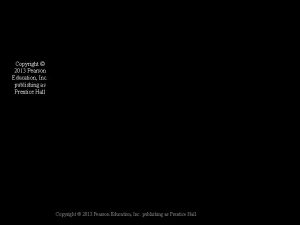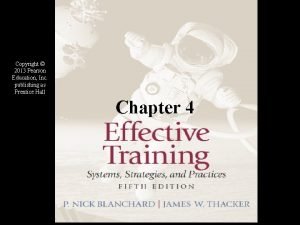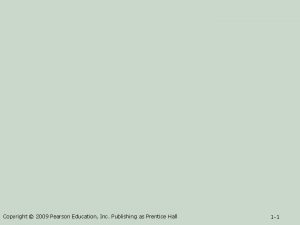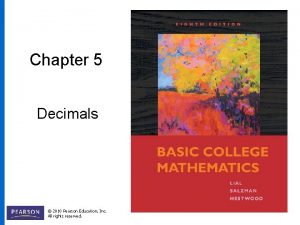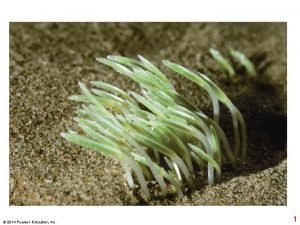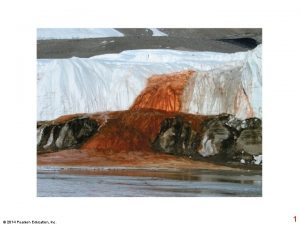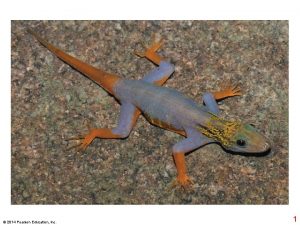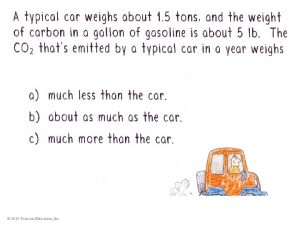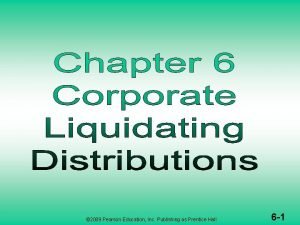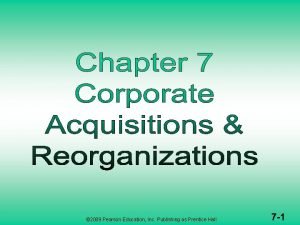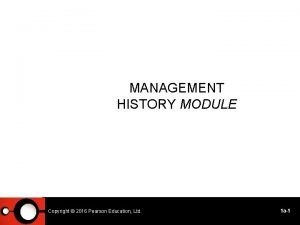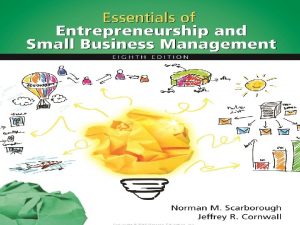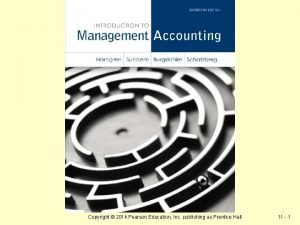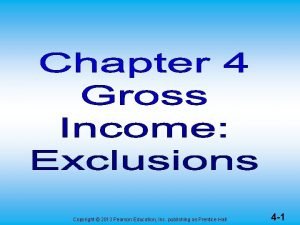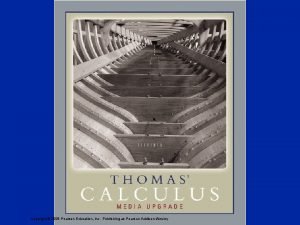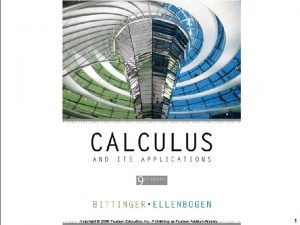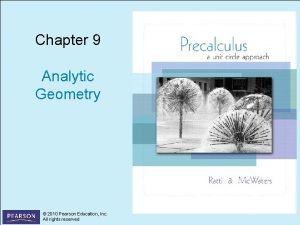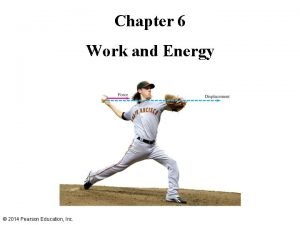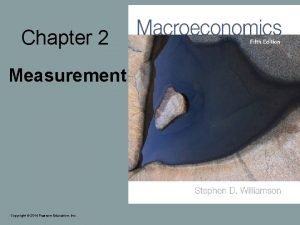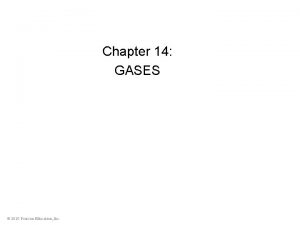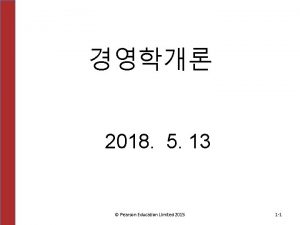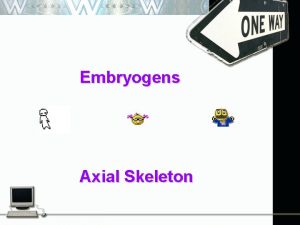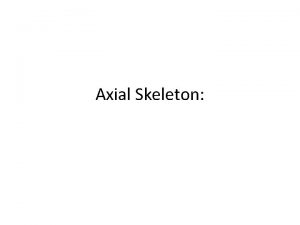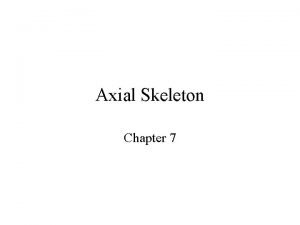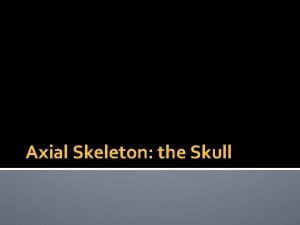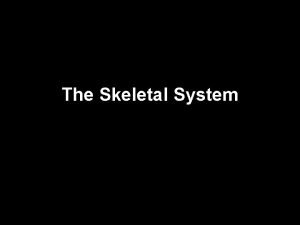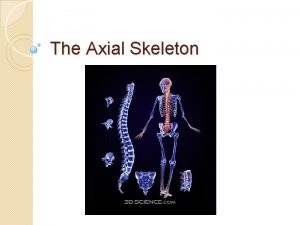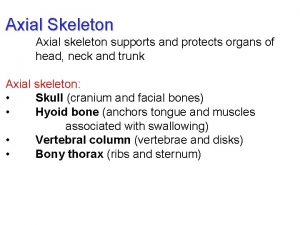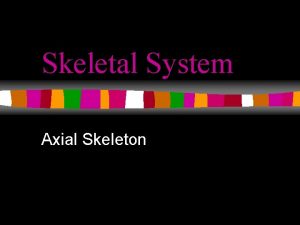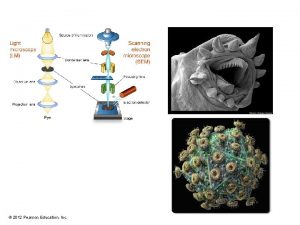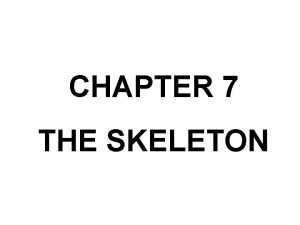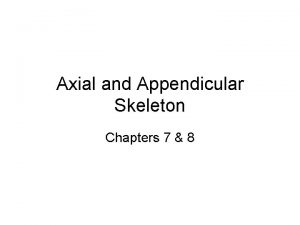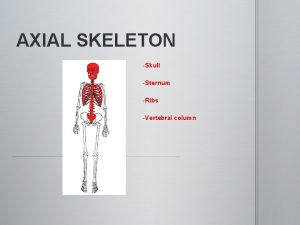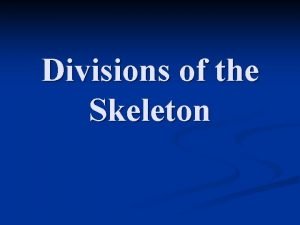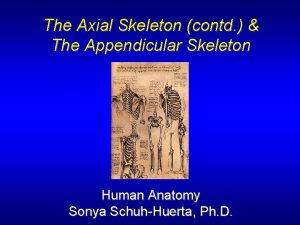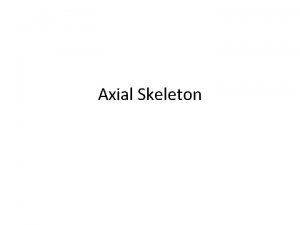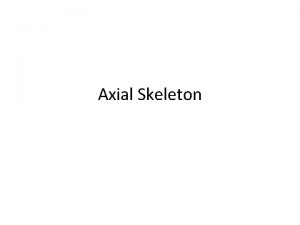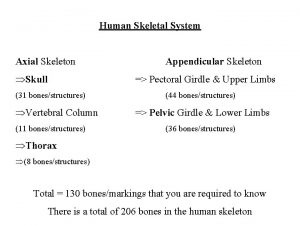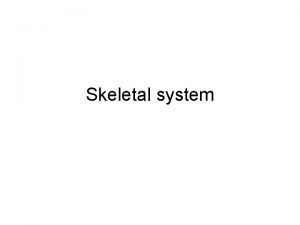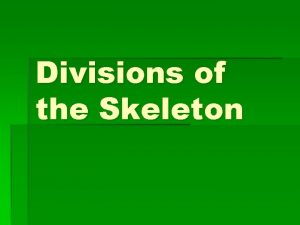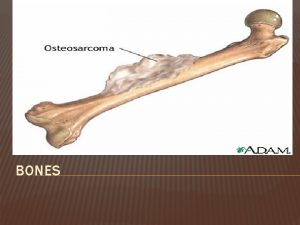Chapter 7 Axial Skeleton 2012 Pearson Education Inc






















































































- Slides: 86

Chapter 7 Axial Skeleton © 2012 Pearson Education, Inc.

Skeletal System • The skeleton forms the framework for the body • Attachment site for muscles; allowing movement • Identification of bones, their landmarks and openings allows one to identify other structures found in the body • 206 bones found in the adult body (infants with more—some bones fuse later) Skeletal system divided into the Axial skeleton and the appendicular skeleton Axial skeleton: bones forming the “longitudinal axis” of the skeleton. Total 80 bones • Composed of the skull (cranium and facial bones), vertebral column (vertebrae, sacrum, coccyx), thorax (ribs and sternum), auditory ossicles and hyoid bone Appendicular skeleton: bones making up the extremities (upper and lower limbs) and the pelvic and pectoral girdles (bones connecting extremities to axial skeleton). Total of 126 bones 2 © 2012 Pearson Education, Inc.

• • • Axial Skeleton: blue skull (cranium) • facial bones vertebral column • vertebrae • sacrum • coccyx thorax • ribs • sternum auditory ossicles hyoid bone Appendicular skeleton: tan • upper and lower limbs • pelvic and pectoral girdles • connect extremities to axial skeleton © 2012 Pearson Education, Inc.

• Long bones: longer than wide. • Ex. humerus (arm bone) • Compact bone at diaphysis and epiphyses • Short bones: length and width relatively equal. • Ex. Carpal bones • Compact bone covers spongy bone • Flat bones: bones relatively flat. • Ex. Cranial bones -skull • Compact bone “sandwiching” spongy bone • Irregular bones: complex shapes. • Ex. vertebral bones • Variable amount of compact bone covering spongy bone • Sesamoid: sesame seed shape. • Ex. patella (knee caps) • Compact bone covers spongy bone • Protect tendons from wear © 2012 Pearson Education, Inc. Bone Types

Bone Surface Markings Openings and Depressions • Foramen- oval to round opening in bone • Fossa- depression on bone –large or small • Meatus- canal-like passage • Sulcus/Grovedepression or furrow • Fissure- narrow, slitlike opening • Sinus- cavity within bone –filled with AIR • Alveolus- pit or socket= teeth 5 © 2012 Pearson Education, Inc.

Bone Surface Markings Facet – flat articulating surface on bone Head- bony expansion on neck of bone Condyle- round articulating projection Ramus- arm-like portion of bone: jaw 6 © 2012 Pearson Education, Inc.

Bone Markings - Projections • Tuberosity- rough elevated surface • Trochanter- very large, blunt projection • Tubercle- small rounded process • Crest- narrow ridge • Line- narrow ridge; smaller than crest (nuchal line) • Epicondyle- raised areas near condyle • Spine- sharp, slender projection • Protuberance- bony outgrowth- chin • Process- bony projection © 2012 Pearson Education, Inc. 7

The Skull • 22 bones joined together by sutures (immovable joints) • 8 cranial bones surround cranial cavity which encloses the brain • 14 facial bones support teeth, facial and jaw muscles • Cavities - orbits, nasal cavity, oral (buccal) cavity, middle-, and inner ear cavities, and paranasal sinuses • paranasal sinuses – frontal, sphenoid, ethmoid, and maxillary • lined by mucous membrane and air-filled • lighten the anterior portion of the skull • act as chambers that add resonance to the voice 8 -8 © 2012 Pearson Education, Inc.

© 2012 Pearson Education, Inc.

The Skull • Cranial Bones (8) • 1 Occipital, 2 Parietal, 1 Frontal, 2 Temporal, 1 Sphenoid, 1 Ethmoid • Sutures • The immovable joints of the skull • The four major sutures 1. Lambdoid suture 2. Coronal suture 3. Sagittal suture 4. Squamous suture © 2012 Pearson Education, Inc.

© 2012 Pearson Education, Inc.

Cranial Fossa Anterior cranial fossa Frontal lobe Temporal lobe Middle cranial fossa Cerebellum Posterior cranial fossa Middle cranial fossa Anterior cranial fossa (a) Superior view (b) Lateral view • cranium (braincase) – protects the brain and associated sense organs; does not expand-serious problem if brain swells • base is divided into three basins that comprise the cranial floor • anterior cranial fossa holds the frontal lobe of the brain • middle cranial fossa holds the temporal lobes of the brain • posterior cranial fossa contains the cerebellum 8 -12 © 2012 Pearson Education, Inc.

Axial Skeleton- Skull Facial Bones: 14 • Form the framework of the face and protect openings to digestive and respiratory systems • Protect and support special sense organs involved in vision, taste, smell, hearing and balance. Include: § Maxillary (paired) § Zygomatic (paired) § Nasal (paired) § Lacrimal (paired) § Palatine (paired) § Inferior nasal conchae/turbinates (paired) § Vomer § Mandible 13 © 2012 Pearson Education, Inc.

Facial Bones PALATINE BONE LACRIMAL BONE ZYGOMATIC BONE NASAL BONE MAXILLA INFERIOR NASAL CONCHA MANDIBLE © 2012 Pearson Education, Inc. VOMER

• Cranial cavity: holds the brain • Nasal cavity Cavities of the Skull • Buccal cavity: mouth • Middle and inner ear cavities • Orbits: eye sockets • Paranasal sinuses 15 © 2012 Pearson Education, Inc.

Axial Skeleton--Skull Sinus cavities found within several bones • Paranasal sinuses---open into the nasal cavity; lined with mucous membranes and function as resonating chambers. • Filled with air- lightens the weight of anterior facial bones • Frontal sinuses • Ethmoid sinuses • Sphenoid sinuses • Maxillary sinuses 16 © 2012 Pearson Education, Inc.

The Cranial Bones of the Skull • • • Occipital Parietal (2) Frontal Temporal (2) Sphenoid Ethmoid Bones enclose the cranial cavity which contains the brain and its fluids, blood vessels, nerves, and membranes © 2012 Pearson Education, Inc.

The Cranial Bones of the Skull The Frontal Bone • Located in the anterior cranium • Forms the roofs of the orbits • Forms most of the cranial floor (anterior) • Frontal squama (forehead) • Supra-orbital margin (protects eye) • Frontal sinuses • Supra-orbital foramen/notch • For blood vessels of eyebrows, eyelids, and frontal sinuses © 2012 Pearson Education, Inc.

The Cranial Bones The Parietal Bones • Form the roof and lateral sides of the cranium • Articulates with parietal, occipital, temporal, frontal, and sphenoid bones © 2012 Pearson Education, Inc.

Temporal Cranial Bones Functions of the temporal bones i. Part of lateral walls of cranium and zygomatic arches ii. Articulate with mandible iii. Surround and protect inner ear iv. Attach jaw and head muscles Sections: petrous, tympanic and Squamous • Petrous Part • Contains the essential parts of the organ of hearing; one of hardest bone in the body • Tympanic part surrounds the external acoustic meatus © 2012 Pearson Education, Inc.

Squamous part anterior and superior portion; attachment for temporalis muscle © 2012 Pearson Education, Inc.

The Cranial Bones- Temporal Bone • External auditory meatus: • bony canal that allows sound waves to enter middle ear • Mastoid Process • For muscle attachment • Contains mastoid air cells connected to middle ear • Zygomatic process: bony lateral projection--meets up with the temporal process of the zygomatic bone; forming zygomatic arch (cheekbone) • Styloid Process • To attach tendons and ligaments of the hyoid, tongue, and pharynx © 2012 Pearson Education, Inc. Mandibular fossa: depression that articulates with the mandibular condyle of the mandible (lower jaw bone) forming temporomandibular joint (TMJ) condyle of the

Carotid canal Cranial Bones Temporal Bones Opening for carotid arteries Jugular foramen Between occipital and temporal bones. Opening for jugular veins Squamous Petrous Internal auditory meatus: opening that allows facial nerve and vestibulocochlear nerve to pass © 2012 Pearson Education, Inc. 23

© 2012 Pearson Education, Inc.

The Cranial Bones The Occipital Bone • Foramen magnum connects cranial and spinal cavities; large opening for the spinal cord • External occipital protuberance- bony projection that serves as an attachment site for connective tissue- ligament to 7 th vertebrae, binds skull to vertebral column • Occipital condyles oval bony projections that articulate with superior articulating facets of C 1 (first cervical vertebra forming atlanto-occipital joint) • Inferior and superior nuchal lines: bony ridges that extend from the external occipital protuberance; serve as attachment sites for muscles and ligaments © 2012 Pearson Education, Inc.

© 2012 Pearson Education, Inc.

Sphenoid • • • Cranial Bones Found at the middle part of the base of the skull Unites cranial and facial bones Strengthens sides of the skull Forms the floor and posterior and lateral walls of the orbit Appearance of a butterfly when viewed anteriorly Sella turcica: “Turkish saddle” on superior surface; houses the pituitary gland. • Hypophyseal Fossa: A depression within the sella turcica holds the pituitary gland • Greater wing: form part of the anterio-lateral floor of the cranium and lateral wall of the skull; fits between squamous and petrous parts of temporal bone; contains numerous foramen, remains a separate bone even after birth • Lesser wing: superior and anterior to greater wings; form the posterior walls of the orbit; contains optic canal, superior orbital 27 fissure allows access to several cranial nerves © 2012 Pearson Education, Inc.

Sphenoid © 2012 Pearson Education, Inc.

Copyright © The Mc. Graw-Hill Companies, Inc. Permission required for reproduction or display. Optic foramen Hypophyseal fossa Lesser wing Greater wing Foramen rotundum Anterior clinoid process Foramen ovale Foramen spinosum Sella turcica Dorsum sellae (a) Superior view Lesser wing Dorsum sellae Greater wing Superior orbital fissure Foramen rotundum Body Foramen ovale Lateral pterygoid plate Medial pterygoid plate Pterygoid processes (b) Posterior view © 2012 Pearson Education, Inc.

Cranial Bones: Sphenoid Bone • Optic foramen: opening for the optic nerve; seen between the lesser wings and the body of the sphenoid • Superior orbital fissure: bony slit between the greater and lesser wings where nerves controlling eye movement pass • Pterygoid processes: inferiorly directed bony projections; attachment site for muscles of the lower jaw and soft palate used in mastication (chewing) • Hypophyseal Fossa: A depression within the sella turcica holds the pituitary gland Foramen associated with the sphenoid: § foramen ovale and foramen rotundum- trigeminal nerve § foramen spinosum –arteries for meninges; trigeminal Sphenoid sinuses: found in the body of the sphenoid; empty into the nasal cavity 30 © 2012 Pearson Education, Inc.

Copyright © The Mc. Graw-Hill Companies, Inc. Permission required for reproduction or display. Hypophyseal fossa Optic foramen Lesser wing Greater wing Foramen rotundum Sella turcica Anterior clinoid process Dorsum sellae Foramen ovale (a) Superior view Foramen spinosum Lesser wing Dorsum sellae Greater wing Superior orbital fissure Body Foramen rotundum Foramen ovale Lateral pterygoid plate Medial pterygoid plate (b) Posterior view © 2012 Pearson Education, Inc. Pterygoid processes

https: //s 3. amazonaws. com/classconnection/28/flashcards/912028/jpg/cra nial_fossa 1318363194773 -14 B 146 D 80 A 84 D 916625. jpg © 2012 Pearson Education, Inc.

Cranial Bones Ethmoid Bone: • Anterior cranial floor location; medial to the orbits • Forms part of the medial walls of the orbits • Superior portion of nasal septum (bony divider of nasal cavity) • Superior potion of the nasal cavity • Bone is delicate; susceptible to injury from a sharp blow. Force of a blow can drive bone fragments into the brain. Damage can lead to infection, loss of smell and/or taste • Ethmoid sinuses: formed by ethmoid cells © 2012 Pearson Education, Inc. 33

Cranial Bones: Ethmoid Structures § Cribiform plate: forms roof of nasal cavity; • Crista galli: projection from cribiform plate; attachment point for the dura mater (outermost membrane covering the brain) • Cribiform (olfactory) foramina- olfactory bulbs rests in these depressions-allows passage of olfactory nerves to brain § Perpendicular plate: midline bony plate forming the superior, anterior portion of the nasal septum § Septum divides nasal cavity into left and right spaces called nasal fossae § Two lateral masses: (Labyrinth) superior and middle nasal conchae: bony projections in the nasal cavity; cause inhaled air to make contact with mucous membranes warming, filtering and humidifying the air before going to the lungs 34 © 2012 Pearson Education, Inc.

Ethmoid Bone Cribiform plate Crista galli © 2012 Pearson Education, Inc.

Nasal Septum http: //www. google. com/imgres? imgurl=http: //pennstatehershey. org/healthinfo/graphics/ images/en/8870. jpg&imgrefurl=http: //pennstatehershey. org/healthinfo/hie/3/100038. ht m&usg=__Tz. Ao. X 8 V 7 s 14 Li 7_3 z 8 a 5 KMX 7 OLE=&h=320&w=400&sz=13&hl=en&start=1 3&zoom=1&tbnid=NS 3 os. IMJUwo. Mn. M: &tbnh=137&tbnw=171&prev=/images%3 Fq%3 Dethmoid%2 Bbone%26 um%3 D 1%26 hl%3 Den%26 biw%3 D 1009%26 bih%3 D 749%26 t bs%3 Disch: 10%2 C 449&um=1&itbs=1&iact=hc&vpx=548&vpy=290&dur=109&hovh=20 1&hovw=251&tx=102&ty=80&ei=R 96 l. TICGNoiengfb 9 Li. QAQ&oei=Pt 6 l. TMLf. K 8 v. Gn. Ae. V vi. QAQ&esq=2&page=2&ndsp=20&ved=1 t: 429, r: 3, s: 13&biw=1009&bih=749 © 2012 Pearson Education, Inc.

Copyright © The Mc. Graw-Hill Companies, Inc. Permission required for reproduction or display. Crista galli Cribriform plate Cribriform foramina Frontal bone Frontal sinus Nasal bone Sella turcica Nasal conchae: Superior Middle Sphenoid sinus Inferior Nasal cartilages Occipital bone Sphenoid bone Anterior nasal spine Palatine bone Incisive foramen Lacrimal bone Lip Maxilla Incisor © 2012 Pearson Education, Inc.

Ethmoid Bone Structures • Perpendicular plate • Ethmoid air cells • ( Sinuses) Middle nasal concha http: //img. tfd. com/Mosby. MD/thumb/ethmoid_bone. jpg © 2012 Pearson Education, Inc.

http: //legacy. owensboro. kctcs. edu/gcaplan/anat/notes/Image 525. gif © 2012 Pearson Education, Inc. http: //upload. wikimedia. org/wikipedia/commons/thumb/6/65/Gra y 854. png/250 px-Gray 854. png

Ethmoid Bone Structures © 2012 Pearson Education, Inc.

The Facial Bones • 2 Maxillae (maxillary bones) • 2 Palatine bones • 2 Nasal bones • 2 Inferior nasal conchae • 2 Zygomatic bones • 2 Lacrimal bones • 1 Mandible • 1 Vomer © 2012 Pearson Education, Inc.

Fig. 8. 3 Copyright © The Mc. Graw-Hill Companies, Inc. Permission required for reproduction or display. Frontal bone Glabella Coronal suture Squamous suture Supraorbital foramen Parietal bone Supraorbital margin Temporal bone Sphenoid bone Lacrimal bone Ethmoid bone Nasal bone Middle nasal concha Zygomatic bone Infraorbital foramen Vomer Inferior nasal concha Maxilla Mandible Mental protuberance © 2012 Pearson Education, Inc. Mental foramen

Facial Bones NASAL BONES Form the bridge of the nose ©http: //2. bp. blogspot. com/_P 3 UBCOXLLj. Q/TL 0 h 9 U 5 VIZI/AAAAr 5 o/0 Lv 13 Totyz 4/s 1600/nasal_bones_medial. jpg 2012 Pearson Education, Inc.

MAXILLAE Facial Bones • Originally paired bones--fuse midline; the “upper jawbone” • Supports upper teeth • Forms the floor of the orbits, lateral walls and floor of the nasal cavity • (the hard palate--divides the oral from the nasal cavity; called the palatine process of the maxilla) • Failure of the maxillary bones to fuse at the palatine process result in a cleft palate. • Soft palate skeletal muscle and glandular tissue no bone • Contains maxillary sinuses that drain into the nasal cavity palatine process Palatine Bone 44 © 2012 Pearson Education, Inc.

http: //www. google. com/search? hl=en&tbo=d&q=birth+defects&tbm=isch&tbs= simg: CAQSYgm. WKUBGCZa. TQhp. OCx. Cwj. Kc. IGjw. KOgg. BEh. Sl. A 7 QF 2 w. O_1 Ba k. E 2 QPm. A 50 Fq. QXABBog 4 Klrb. Hmn 1 Yega 36 nn. YPoe 2 OAi. Wcw 9 ly. Ep. Vmcy. Zv. I k. Lc. MCx. COrv 4 IGg. AMIe. Ufoifmdbw 9&sa=X&ei=028 e. UZG 1 OOOa 2 AWY 9 o. Cg. A Q&ved=0 CDQQwg 4&biw=1024&bih=673 © 2012 Pearson Education, Inc.

Facial Bones: Maxilla • Infraorbital foramen: openings for nerve and blood vessels just inferior to the orbits via foramen rotundum of sphenoid • Alveolar processes (bony ridge): where teeth articulate at alveoli (sockets) • Orbital rim protects eye and orbit 46 © 2012 Pearson Education, Inc.

The Facial Bones The Maxillae • Incisive foramen: opening in the palatine process for the passage of blood vessels and nerves Palatine Bones • Form the posterior 1/3 rd of hard palate (maxilla makes up the anterior 2/3) • Contributes a small portion of the eye orbit © 2012 Pearson Education, Inc.

Inferior Nasal conchae/turbinates • bony projections in the nasal cavity; creates air turbulence and increases surface area for the warming, filtering and humidifying of incoming air Facial Bones Vomer Inferior and slightly posterior portion of the nasal septum. Articulates with the perpendicular plate of the ethmoid to form the nasal septum 48 © 2012 Pearson Education, Inc.

Inferior Nasal Conchae 8 -49 © 2012 Pearson Education, Inc.

Vomer • Inferior half of the nasal septum • Supports cartilage of nasal septum 8 -50 © 2012 Pearson Education, Inc.

FRONTAL BONE Frontal sinuses ETHMOID NASAL BONE PALATINE BONE (bony palate) MAXILLA (bony palate) Sphenoidal sinuses SPHENOID Superior Middle INFERIOR NASAL CONCHA A sagittal section through the skull, with the nasal septum removed to show major features of the wall of the right nasal cavity. The sphenoidal sinuses are visible. © 2012 Pearson Education, Inc. Nasal conchae of ethmoid

Lacrimal Bones Facial Bones • Form part of the medial walls of the orbit • Smallest facial bone • Include lacrimal fossa which allow tears to drain into lacrimal sacs Zygomatic Bones • Form the “cheekbones” • Temporal process of the zygomatic bone joins the zygomatic process of temporal bone to form zygomatic arch • Forms lateral wall of the orbit 52 © 2012 Pearson Education, Inc.

© 2012 Pearson Education, Inc.

Mandible Facial Bones • Only movable bone • jaw joint between mandibular fossa of the temporal bone and condyloid process of the mandible • Holds the lower teeth • Attachment of muscles of mastication • temporalis muscle onto coronoid process • masseter muscle onto angle of mandible • The lower jaw bone • Strongest of the facial bones • A depression on the medial surface for submandibular salivary gland 8 -54 © 2012 Pearson Education, Inc.

Mandible Characterized by several landmarks: Facial Bones • Body: main portion of the mandible; curved horizontal portion • Rami: the arm of the mandible; vertical portions • Angle: point where the rami project off of the body • Mandibular condyle and condylar process: rounded knob and projection articulates mandibular fossa and articular tubercle of the temporal bone-forms temporomandibular joint (TMJ) • Coronoid process: projection that is the attachment site for the temporalis muscle (used in chewing) 55 © 2012 Pearson Education, Inc.

Mandible • Mental Protuberance: attachment for facial muscles • Mandibular foramen: opening allows a branch of the trigeminal nerve to innervate the lower teeth, blood vessels to profuse the area • Mental foramen: opening in the anterior surface of mandible body for the passage of blood vessels and nerves to lips/chin • Alveolar process: bony ridge where teeth articulate with alveoli • Mandibular symphysis: mid-line fusion point of the two parts of the mandible © 2012 Pearson Education, Inc. Facial Bones

Hyoid Bone • U shaped bone--does not articulate with another bone • Found in the anterior cervical region--inferior to the mandible • Connects to styloid process of temporal bone via ligaments and muscles • Attaches muscles of the larynx, pharynx, and tongue • muscles involved in chewing and swallowing • Consists of body and lesser and greater horns Hydoid bone is often examined in forensics to determine cause of death from strangulation 57 © 2012 Pearson Education, Inc.

Figure 7 -13 The Orbital Complex Optic canal/foramen - transmits optic nerve Superior orbital fissure- opening for several cranial nerves Inferior orbital fissure –opening for maxillary nerve FRONTAL BONE SPHENOID Supra-orbital notch Optic canal ETHMOID Superior orbital fissure LACRIMAL BONE Lacrimal sulcus Nasolacrimal canal PALATINE BONE Inferior orbital fissure ZYGOMATIC BONE Infra-orbital MAXILLA groove foramen © 2012 Pearson Education, Inc.

Fontanelles • Areas of incomplete cranium intramembranous ossification • Will eventually ossify to form sutures • Provide flexibility for fetal head as it goes through birth canal • Allows for growth of brain • Anterior Fontanelle • Frontal, sagittal, and coronal sutures/ closes within 2 yrs • Occipital Fontanelle • Lambdoid and sagittal sutures / closes within 2 mos • Sphenoidal Fontanelles • Squamous and coronal sutures / closes 3 months • Mastoid Fontanelles • Squamous and lambdoid sutures/ closes by one year © 2012 Pearson Education, Inc.

Vertebral Column Composed of vertebrae that function to: • Support the body • Protect the spinal cord • Act as anchoring sites for muscle • Support the head • Act as attachment points for the ribs and pelvic girdle. Composed of 26 vertebrae in the adult (33 in children) • Sacral and coccygeal vertebrae fuse in adulthood 60 © 2012 Pearson Education, Inc.

Vertebral Column Five major regions • Cervical (7) • Thoracic (12) • Lumbar (5) • Sacral (1); 5 vertebrae fused • Coccygeal (1); 4 vertebrae fused 61 © 2012 Pearson Education, Inc.

Vertebral Column Curves of the vertebral column: • Function to absorb shock, provide strength 4 normal curves: • Thoracic and sacral curves are concave; PRIMARY curves (present during fetal development) or accommodation curves (accommodate internal organs) • Cervical (3 mo) and Lumbar (1 yr) curves are convex; SECONDARY curves (appear after birth) or compensation curves (shift body weight for upright posture) • Develop as infant is able to hold up the head and balance weight to stand /walk • These four curves develop from the single thoracic curve of the newborn 62 © 2012 Pearson Education, Inc.

Abnormal Curvatures Kyphosis (hunchback): exaggerated curvature of the thoracic region; due to : osteroporosis, osteomalacia, adolescence boys-wrestling, weight lifting © 2012 Pearson Education, Inc. Lordosis (swayback): exaggerated curvature of the lumbar region Scoliosis: Abnormal lateral bending of the spinedevelopment issue-adolescent girls

© 2012 Pearson Education, Inc.

Vertebrae • Vertebrae of different regions differ in their shape, size, and bony landmarks • Body: thick, anterior disc shaped Intervertebral discs sit on the superior and inferior surface. Supports most of the weight • Pedicles: Walls of the vertebral arch; bony bridges projecting laterally and posteriorly from the body to the laminae • Laminae: Roof of the vertebral arch; bony bridges that connect with the pedicles anteriorly and with the spinous process posteriorly. • Transverse processes: lateral bony projections from the junction of the pedicles and laminae; attachment site for muscles • Spinous process: posteriorly oriented bony projection; attachment sites for muscles 65 © 2012 Pearson Education, Inc.

© 2012 Pearson Education, Inc.

• Vertebral foramen: opening formed by the pedicles and laminae of the vertebrae • Vertebral canal • Formed by vertebral foramina • Encloses and protects the spinal cord • Intervertebral foramen: opening formed between adjoining vertebrae where spinal nerves exit to the periphery • Superior articulating processes: processes that allow articulation with the inferior articulating process of the vertebra just above it • Inferior articulating processes: processes that allow articulation with the superior articulating processes of the vertebra just below it. Vertebrae 67 © 2012 Pearson Education, Inc.

Intervertebral discs • Discs found between the vertebrae from cervical region to the lumbar region • Disc consists of two portions: • Nucleus fibrosus: outer ring of fibrocartilage • Nucleus pulposus: soft elastic material inside the nucleus fibrosus • Discs allow for a strong joint between bones, allows for flexibility, and flatten to absorb shock • With aging the disc become stiffer and less thick---results in decreased height © 2012 Pearson Education, Inc. 68

Disorders Herniated disc • 1% SHORTER at the end of the day due to body weight compressing the disc and squeezing out fluid. During sleep fluid reabsorbed • Stressors cause shift of discs--may result in rupture of nucleus fibrosus and protrusion of nucleus pulposus • If nerves leading to the lower extremity affected, may be neurological symptoms—muscle weakness, numbness, tingling. • Typically occurs in the lumbar region due to supporting weight and providing flexibility for bending Spina bifida • a congenital (birth) defect • Failure of vertebral laminae to unit • Nervous tissue is unprotected • paralysis © 2012 Pearson Education, Inc. 69

© 2012 Pearson Education, Inc.

Vertebral Regions • Vertebrae are numbered • By region, from top (superior) to bottom (inferior) • C 1 articulates with skull, L 5 with sacrum • Vertebrae of each region • Have characteristics determined by functions • Regions of the Vertebral Column • Cervical (C) • Thoracic (T) • Lumbar (L) • Sacral (S) • Coccyxgeal (Co) © 2012 Pearson Education, Inc.

Vertebral Column Regions The typical cervical vertebrae : • Small/ small oval body • Triangular shaped vertebral foramen that are large • Transverse foramen present: foramen for the passage of vertebral arteries, veins and nerves 72 © 2012 Pearson Education, Inc.

C 1 known as the atlas; supports weight of the skull • no spinous process; Superior articulating facets articulate with occipital condyles of occipital bone (atlanto-occipital joint) • allows nodding of head (“yes”) Cervical C 2 known as the axis • Tip of spinous process is notched (bifid) • Contains a tooth like projection at the body known as the dens or odontoid process-forms a pivot point with C 1 (atlanto-axial joint) • allows for the lateral turning of the head. (“no”) • attach muscles of head and neck Transverse ligament- arches across ring of atlas; holds the dens in contact with the anterior arch 73 © 2012 Pearson Education, Inc.

Atlas and Axis Articulation Superior YES articulate facet That holds the head NO Atlas = C 1 Has no body Just a ring Axis = C 2 8 -74 © 2012 Pearson Education, Inc.

Vertebral Column Regions Thoracic Vertebrae: T 1 -T 12 • Larger than cervical vertebrae • Round vertebral foramen • Heart-shaped bodies; contain facets or edifices for the articulation with the heads of ribs • Longer and larger transverse processes • T 1 -T 10 have facets that articulate with rib tubercles • Long, sharp, inferior directed spinous processes • Facets for the articulation of ribs © 2012 Pearson Education, Inc. 75

Thoracic Vertebrae 76 © 2012 Pearson Education, Inc.

Vertebral Column Regions Lumbar Vertebrae • Largest of the vertebrae--support large amounts of body weight • Bodies large and oval shaped • Vertebral foramen triangular in shape • Projections are short and blunt • Spinous process short and “hatchet” shaped; attachment of lower back muscles • Superior articulating facets are medially directed rather than superiorly directed 77 © 2012 Pearson Education, Inc.

Lumbar Vertebrae © 2012 Pearson Education, Inc.

The Sacrum • Is curved, more in males than in females • Consists of five (5) fused sacral vertebrae • Fusion of sacral vertebrae; begins mid-teens completed by early 30’s • Leaving transverse lines • Protects reproductive, urinary, and digestive organs • Attaches: • The axial skeleton to pelvic girdle of appendicular skeleton • Lateral auricular surface articulates with ilium of coxal bones forming sacroiliac joint. • Broad muscles that move thigh © 2012 Pearson Education, Inc.

The Sacrum • Sacral hiatus • Opening at the inferior end of the sacral canal • Forms opening for exit of inferior spinal nerves • Anterior and Posterior sacral foramina-opening for nerves and blood vessels • Median sacral crest • Fused spinous processes • Lateral sacral crest-Attach to muscles of lower back and hip • Fused transverse processes • Auricular surface • Thick, flattened area • Articulates with pelvic girdle (forming sacroiliac joint) • Sacral tuberosity • Rough area • Attaches ligaments of the sacroiliac joint • Sacral canals- continuation of vertebral cavity- passageway for spinal nerves; Replaces the vertebral canal © 2012 Pearson Education, Inc.

The Sacrum © 2012 Pearson Education, Inc.

Coccyx © 2012 Pearson Education, Inc. • Single, small bone • Commonly called the “tailbone” • Attaches ligaments and a constricting muscle of the anus • Mature coccyx (20 -30 yrs) • Consists of three to five fused coccygeal vertebrae • attached to the sacrum by a fibrocartilaginous joint • Coccygeal cornua • Two knob-like upward extensions for the attachment of coccygeal ligament that holds the spinal cord in place • Attachment site for muscles of pelvic floor • Fractured by fall or during childbirth

Thorax Thoracic cage • Consists of sternum, ribs, costal cartilage and thoracic vertebral bodies • Supports the thoracic cavity • Protects organs of the thoracic cavity • Heart, lungs, and thymus • Attaches muscles for • respiration • the vertebral column • the pectoral girdle and the upper limbs 83 © 2012 Pearson Education, Inc.

Sternum (a flat bone): Thorax Consists of four unfused bones. Completes fusion about age 25 • Jugular notch • a target for finger strikes in such martial arts as Jiu-Jitsu. Seen in Matrix movie • point of attraction by many men and women. Jewelry enhancement • Manubrium: Broad, triangular superior portion; articulates with the clavicles and the first two ribs • Body: forms most of the sternum; articulates with cartilage of ribs 3 -10 • Xiphoid process: the last part of sternum to fuse; made of hyaline cartilage that ossifies at around 40. • Can easily be broken away therefore caution must be used for administering CPR to in older individuals • Attachment site for abdominal muscle • Attaches to the sternal body, the diaphragm and rectus abdominis muscles © 2012 Pearson Education, Inc.

Thorax Ribs: • True ribs (1 -7) join directly with sternum via costal cartilage • False ribs (8 -12) do not directly attach to sternum via own cartilage or do not connect at all • Ribs 8 -10 - fuse together and merge with cartilage before reaching the sternum • Floating ribs (11 and 12) connect only to the vertebrae and back muscles; do not connect to sternum at all; 85 © 2012 Pearson Education, Inc.

Thorax Ribs: • 12 pairs • Each rib articulates with posteriorly with the corresponding thoracic vertebra • the head of each rib fits into a facet on the body of a vertebra or the superior and inferior demifacets on adjacent vertebrae • Articular part of rib tubercle joins to vertebra articulating facet on transverse process of inferior vertebra • Costal groove protects blood vessels and nerves • Body is the main part of the rib • Costal angle: area of the rib with the greatest increase in curvature © 2012 Pearson Education, Inc. 86
 Axial skeleton vs appendicular
Axial skeleton vs appendicular Axial vs appendicular
Axial vs appendicular Sternocostal angle
Sternocostal angle Pearson education inc. 2012
Pearson education inc. 2012 2012 pearson education inc
2012 pearson education inc Pearson education 2012
Pearson education 2012 2012 pearson education inc
2012 pearson education inc Olecranal region
Olecranal region 2012 pearson education inc
2012 pearson education inc Pearson education inc. 2012
Pearson education inc. 2012 2012 pearson education inc anatomy and physiology
2012 pearson education inc anatomy and physiology 2012 pearson education inc
2012 pearson education inc 2012 pearson education inc
2012 pearson education inc Pearson education inc. 2012
Pearson education inc. 2012 2012 pearson education inc
2012 pearson education inc Pearson education inc. 2012
Pearson education inc. 2012 2012 pearson education inc
2012 pearson education inc 2012 pearson education inc
2012 pearson education inc 2012 pearson education inc
2012 pearson education inc Pearson education inc. 2012
Pearson education inc. 2012 Pearson education inc all rights reserved
Pearson education inc all rights reserved 2011 pearson education
2011 pearson education 2011 pearson education inc
2011 pearson education inc Pearson education inc publishing as pearson prentice hall
Pearson education inc publishing as pearson prentice hall 2008 pearson prentice hall inc
2008 pearson prentice hall inc Body sutures
Body sutures Receive
Receive Pearson education 2012
Pearson education 2012 2018 pearson education inc
2018 pearson education inc Pearson education limited 2017
Pearson education limited 2017 2017 pearson education inc
2017 pearson education inc 2017 pearson education inc
2017 pearson education inc 2017 pearson education inc
2017 pearson education inc 2017 pearson education inc
2017 pearson education inc 2017 pearson education inc
2017 pearson education inc 2016 pearson education inc
2016 pearson education inc 2015 pearson education inc
2015 pearson education inc 2014 pearson education inc
2014 pearson education inc 2013 pearson education inc
2013 pearson education inc 2013 pearson education inc
2013 pearson education inc 2013 pearson education inc. answers
2013 pearson education inc. answers 2013 pearson education inc
2013 pearson education inc 2010 pearson education inc
2010 pearson education inc 2010 pearson education inc
2010 pearson education inc 2009 pearson education inc
2009 pearson education inc 2016 pearson education inc
2016 pearson education inc 2010 pearson education inc answers
2010 pearson education inc answers 2010 pearson education inc
2010 pearson education inc 2014 pearson education inc
2014 pearson education inc 2014 pearson education inc
2014 pearson education inc 2014 pearson education inc
2014 pearson education inc 2014 pearson education inc
2014 pearson education inc 2014 pearson education inc
2014 pearson education inc Water cycle pearson education
Water cycle pearson education 2014 pearson education inc
2014 pearson education inc 2011 pearson education inc
2011 pearson education inc 2011 pearson education inc
2011 pearson education inc 2011 pearson education inc
2011 pearson education inc 2011 pearson education inc
2011 pearson education inc 2011 pearson education inc
2011 pearson education inc 2011 pearson education inc
2011 pearson education inc 2010 pearson education inc answers
2010 pearson education inc answers 2009 pearson education inc
2009 pearson education inc 2009 pearson education inc
2009 pearson education inc 2016 pearson education inc
2016 pearson education inc 2017 pearson education inc
2017 pearson education inc 2016 pearson education inc
2016 pearson education inc 2016 pearson education inc
2016 pearson education inc 2016 pearson education inc
2016 pearson education inc 2015 pearson education inc
2015 pearson education inc 2014 pearson education inc
2014 pearson education inc 2013 pearson education inc
2013 pearson education inc 2013 pearson education inc
2013 pearson education inc Copyright 2009
Copyright 2009 2009 pearson education inc
2009 pearson education inc Pearson education
Pearson education 2008 pearson education inc
2008 pearson education inc 2008 pearson education inc
2008 pearson education inc 2010 pearson education inc answers
2010 pearson education inc answers 2014 pearson education inc
2014 pearson education inc 2014 pearson education inc
2014 pearson education inc 2010 pearson education inc answers
2010 pearson education inc answers 2015 pearson education inc
2015 pearson education inc 2016 pearson education inc
2016 pearson education inc 2015 pearson education inc
2015 pearson education inc 2014 pearson education inc
2014 pearson education inc 2011 pearson education inc
2011 pearson education inc

